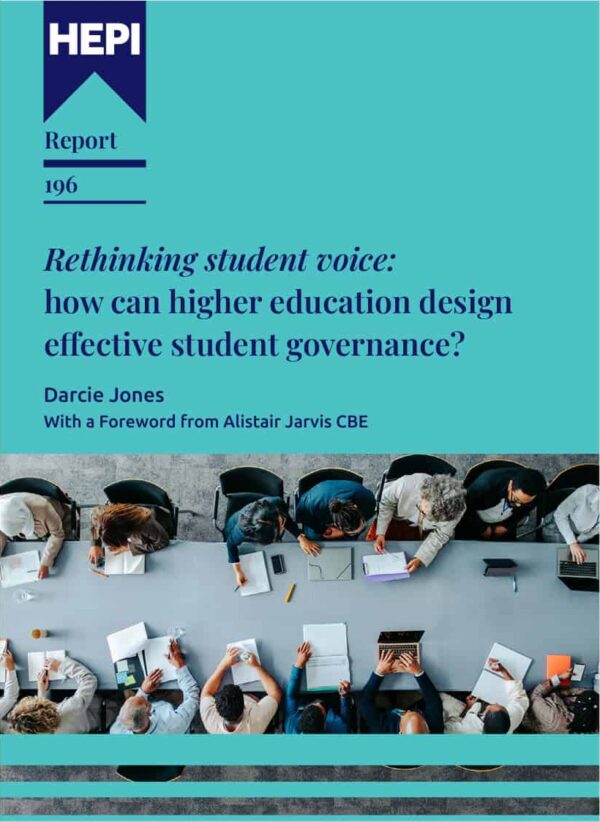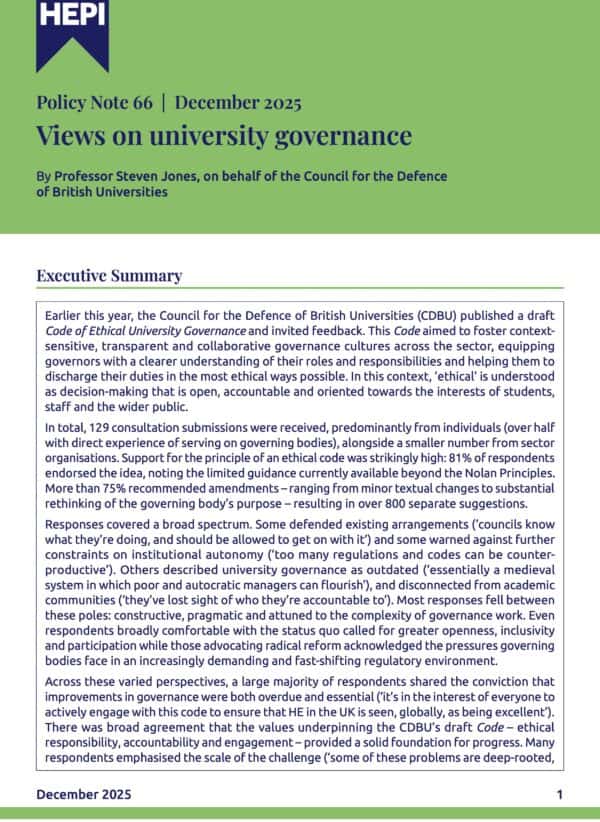Bank holiday reading: Flying the Nest in the wrong direction – How we can attract our ‘lost boys’ back into HE
Archie Rankin is a History & Politics Student at Queen Mary University of London.
HEPI recently published Boys will be boys: The educational underachievement of boys and young men, which discusses the lower entry rates of young men into higher education and proposes solutions, such as a ‘Minister for Men’, to address the gap.
In sociology, the term ‘male flight’ refers to men abandoning fields, activities, or professions when they are perceived as becoming too ‘feminine’ or associated with women. Lisa Wade argues that this is ‘bad long-term strategy for maintaining dominance.’ Education, especially in recent years, has become a battleground for cultural and political struggles, particularly in the wake of growing far-right influence in both Europe and the United States. But is the shift away from higher education by young men simply a cultural power struggle, or are we failing to meet their needs and expectations?
The Impact of Gender Dynamics on Higher Education Participation
Men are increasingly opting out of higher education. The widening gender gap in college enrolment reveals a troubling trend: higher education is now facing what can be described as male flight. In the United States, this gap has expanded dramatically. In 1979, only 200,000 more women attended college than men; by 2021, that number had surged to 3.1 million more women than men. While the COVID-19 pandemic significantly impacted enrollment figures in 2021, this shift underscores a broader trend in gender and education that warrants serious consideration.
A similar pattern is unfolding in the UK. In 2020/21, there were 2.75 million students enrolled in higher education, with women making up 57% of the student body. The undergraduate sector exhibits the largest gender gap. This growth, however, raises critical questions about the future of male participation in higher education.
The Retreat of Men from Higher Education: A Closer Look
The trend of male flight from higher education is unlikely to reverse without targeted intervention. A study by King’s College London highlights that young men today are particularly concerned about the challenges they face in society. Unlike their older counterparts, younger men and women hold vastly different views on education, social issues, and political ideologies. According to a survey of over 3,500 young people aged 16+, young men tend to be less supportive of gender equality initiatives and are increasingly aligning with right-wing political views. Within this context, right-wing political groups, such as Reform UK, advocate for a ‘no-nonsense’ approach to education, emphasizing a patriotic curriculum that they argue better addresses concerns about social equality. Their proposals often reflect a growing sentiment among some groups, particularly white men, who feel that their experiences and challenges do not align with current gender equality initiatives.
While the political rhetoric surrounding this issue is highly charged, it demands serious attention. The key question now is: How can we rebuild young men’s confidence in higher education? This is particularly pressing when considering young men from low-income or disadvantaged backgrounds. Research shows that white working-class men are disproportionately likely to cite the high cost of higher education as a barrier to entry.
Fees and student loans are the biggest concern of young people as they look ahead onto the HE landscape, with over 25% of young Britons thinking that university is not worth it. Alongside this sector-wide issue, young men are retreating from HE in much higher numbers than any of their female or BAME counterparts. This is something that should not be ignored if we want truly inclusive HE.
What Can We Do? Policies to Address Inclusive Education and Rebuild Trust Among Disadvantaged White Men
Many of these issues must be addressed by universities themselves. Male students often feel that higher education fails to cater to their unique needs. Young men are less likely to engage in extracurricular activities – such as sports or student unions – that are integral to the student experience. Neil Raven’s contribution to this blog last year highlights young men feeling unsupported and disengaged, and as with everything in this sector, the solution to this question is not straightforward. To truly address the challenges young men face in education, universities must acknowledge that their needs and experiences are distinct and deserve to be supported in meaningful and effective ways.
When we talk about the financial red flags facing disadvantaged young white men, we’re really addressing the prospect of being burdened with debt—especially when they are just one choice away from avoiding it altogether. Adopting Tim Leunig’s recommendation to shorten the student loan repayment term from 40 years to 20 would give students greater confidence that they can achieve financial freedom by mid-life.
Furthermore, research conducted by the Institute for Fiscal Studies commissioned by the Department for Education (DfE) found that only 1 in 5 students would not be financially better off by going to university. This is reason enough to incentivise young white men back into the warm embrace of higher education.
A shorter repayment term would not only alleviate long-term financial anxiety but also encourage people from all backgrounds to pursue higher education without the fear of being shackled by debt for life. The Higher Education Policy Institute’s own research, despite indicating young women being more debt-averse than men (even with men paying more of the debt due to higher salaries in the longer term), shows that most of our young people are opposed to the Labour government’s tuition fee increase. A shorter repayment term will perhaps not only restore the confidence of our young women – who are already sceptical of the lower salaries they will receive throughout their careers – but reassure all of our young people that student loans are not a lifelong burden, and that we have a system that rewards ambition rather than punishing those who take the leap.
Moreover, this shift could help restore confidence in the value of a degree, particularly for those who currently see university as a risky financial gamble rather than a stepping stone to social mobility. This is, as Mr Raven identifies, especially important as men doubt and call into question graduate outcomes in the long term.
HEPI’s research also indicates that a tuition fee hike is made more palatable if accompanied by an increase in maintenance support. In a piece I wrote for the Sixteenth Council, I referred to the Institute for Fiscal Studies’s proposals regarding maintenance support. One of these was restoring the generosity of maintenance support to 2020 levels, which represents a 16% increase for the 23/24 intake. Yes, this means issuing £1.5bn in maintenance loans, but repayment levels would mean that the cost to the government and the taxpayer would fall to £0.4bn.
Therefore, making HE more attractive for young people – especially those white, working-class young men who are lacking that engagement with education – involves reducing the repayment term for tuition fees down to 20 years and restoring maintenance support to pre-COVID levels. Ultimately, this would, as HEPI’s research indicates, make the recent tuition fee rise more palatable and, in turn, set young minds at ease.
Another way of addressing these practical problems is spearheading a secondary school library-building scheme. The National Literacy Trust identified a strong link between school library use and reading attainment, which is especially important as low reading abilities help to ‘entrench’ education inequality in the UK. The provision and accessibility of school libraries from a young age can help boost attainment in early years and beyond, setting young men on a course that permits more positive thinking about further and then higher education.
The National Literacy Trust’s report also notes that library users receiving free school meals showed higher reading enjoyment and increased reading and writing for pleasure. They tended to read and write a greater variety of material relative to non-library users. In 2021, the Commons Education Committee found that white working class students were ‘by far the largest group of disadvantaged pupils’ with just under a million eligible for free school meals in 2020. Accessible libraries and reading spaces may be the next big step we can take to help disadvantaged pupils. The National Literacy Trust’s report reveals that white working-class boys receiving free school meals are particularly poised to benefit from a campaign of boosting libraries and reading spaces in educational settings, which may help improve their engagement with education as a whole.
A few months ago, I attended the Publishers’ Association’s parliamentary drop-in event, where I learnt a lot about the importance of the relationship between school libraries, reading attainment, and the publishing industry as a whole. I enjoyed reading in my primary school’s small library space, and throughout my time at secondary school, I made use of both the school’s reading spaces and our local community library. Unfortunately, I must recognise that this was an enormous privilege for a white working-class student when it should just be a permanent feature of our outstanding education system.

This is extremely relevant now as I look out on the educational landscape. Young men are falling behind women in education, a significant issue which goes way back to before primary school. According to the Centre for Social Justice (CSJ), ‘From the day they start primary school, to the day they leave higher education, the progress of boys lags behind girls’.
Ultimately, the success of higher education in the 21st century will depend on how effectively universities can adapt to the evolving needs of all students. In the case of young men, this means recognizing their unique challenges and addressing them with targeted, thoughtful solutions. Only by doing so can we create a higher education system that truly serves everyone, regardless of gender.
As Mr Raven notes in his blog contribution, it is certainly ‘our problem, not theirs’.







Comments
Gavin Moodie says:
Surely the under representation of men in higher education is a problem for them as much as society because it leaves them without the benefits of higher education.
I suggest it is worth recalling Ronald Barnett’s response to Raven’s post:
11th March 2024 at 10:34
‘This is a matter that has been observed in the literature since at least the late 1980s.
‘Surely, in any serious effort to get to grips with it one would expect to see concepts and issues of (male) identity, roles, culture(s), labour market(s), educational progression, pedagogical codes and so forth as well as detailed comparisons being made with the educational progress of girls and young women (why is the latter so much better than the former?). Unless the deep societal, economic and cultural levels of the structures at work are exposed and interrogated, efforts to confront the matter are surely not going to be sufficiently penetrative.’
Ronald Barnett
https://www.hepi.ac.uk/2024/03/11/our-problem-not-theirs-young-white-working-class-males-and-higher-education/
Reply
Albert Wright says:
The “everything must be done” to make life easy for those less fortunate needs to be restrained, otherwise they will never understand the need to strive for personal goals.
We must also accept that levelling up will cost more and in most cases will still not be sufficient to enable this group of students to achieve the same incomes as those that come from more wealthy backgrounds.
While the gap in outcomes has been slightly narrowed, we need to recall the decades required to close the gender gap
Reply
Add comment